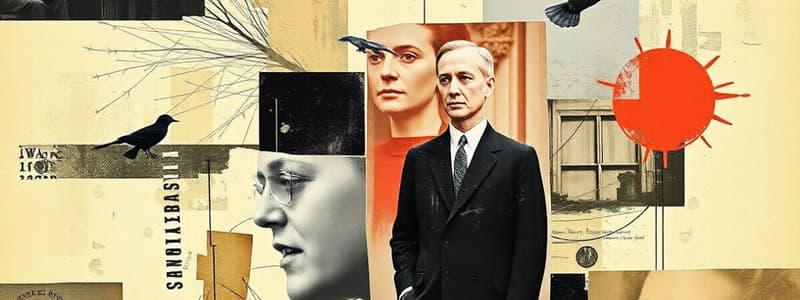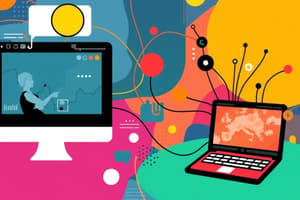Podcast
Questions and Answers
Which of the following is NOT a characteristic of the Pre-Industrial Age?
Which of the following is NOT a characteristic of the Pre-Industrial Age?
- Forging weapons & tools with stones
- Creation of cave paintings
- Development of paper from plants
- Use of power-driven machines (correct)
What technology emerged during the Industrial Age that significantly impacted communication?
What technology emerged during the Industrial Age that significantly impacted communication?
- The printing press (correct)
- Radio
- Internet
- Transistor
Which of the following best describes the key difference between the Industrial Age and the Electronic Age?
Which of the following best describes the key difference between the Industrial Age and the Electronic Age?
- The Industrial Age relied on mechanical devices, while the Electronic Age utilized electronic components. (correct)
- The Industrial Age used steam power, while the Electronic Age used electricity.
- The Industrial Age focused on hand tools, while the Electronic Age focused on power-driven machines.
- The Electronic Age emphasized long-distance communication, unlike the Industrial Age.
Which of these examples best demonstrates information literacy?
Which of these examples best demonstrates information literacy?
Which of the following is NOT a form of traditional media?
Which of the following is NOT a form of traditional media?
What was the pivotal invention that marked the beginning of the Electronic Age?
What was the pivotal invention that marked the beginning of the Electronic Age?
Which era is characterized by the rise of social networks and faster communication due to the internet?
Which era is characterized by the rise of social networks and faster communication due to the internet?
Which of these best represents the concept of media literacy?
Which of these best represents the concept of media literacy?
Which of the following is NOT a mental effect of technology addiction?
Which of the following is NOT a mental effect of technology addiction?
What is one way to prevent or stop cyberbullying?
What is one way to prevent or stop cyberbullying?
Which of the following actions characterizes cyberbullying?
Which of the following actions characterizes cyberbullying?
What is a common feeling experienced by individuals who are addicted to technology?
What is a common feeling experienced by individuals who are addicted to technology?
Which of the following statements about cyberbullying is true?
Which of the following statements about cyberbullying is true?
What is the function of symbolic codes in media language?
What is the function of symbolic codes in media language?
Which of the following is not considered a basic camera shot?
Which of the following is not considered a basic camera shot?
Which of the following devices primarily enables instant access to knowledge?
Which of the following devices primarily enables instant access to knowledge?
What is meant by conventions in media?
What is meant by conventions in media?
Which of the following best describes news?
Which of the following best describes news?
Which of the following is a technical code in media language?
Which of the following is a technical code in media language?
What are microblogs primarily associated with?
What are microblogs primarily associated with?
What role does the laugh track play in a sitcom?
What role does the laugh track play in a sitcom?
What is the term used to describe the process where multiple media technologies are combined into one device?
What is the term used to describe the process where multiple media technologies are combined into one device?
Which of the following is NOT a type of intellectual property?
Which of the following is NOT a type of intellectual property?
Which principle allows limited use of copyrighted material without permission for particular purposes?
Which principle allows limited use of copyrighted material without permission for particular purposes?
Which of the following represents a form of intellectual property violation?
Which of the following represents a form of intellectual property violation?
What does the term 'digital divide' refer to?
What does the term 'digital divide' refer to?
Which guideline should be followed to comply with fair use standards?
Which guideline should be followed to comply with fair use standards?
What is the purpose of a trademark?
What is the purpose of a trademark?
Which of the following is NOT a purpose categorized under fair use?
Which of the following is NOT a purpose categorized under fair use?
Flashcards
Instant Access to Knowledge
Instant Access to Knowledge
Easily finding information that was hard to access before.
Media Language
Media Language
The method of conveying meaning through media texts.
Symbolic Codes
Symbolic Codes
Social signs and symbols that convey meaning.
Written Codes
Written Codes
Signup and view all the flashcards
Technical Codes
Technical Codes
Signup and view all the flashcards
Basic Camera Shots
Basic Camera Shots
Signup and view all the flashcards
News
News
Signup and view all the flashcards
Issues
Issues
Signup and view all the flashcards
Media Literacy
Media Literacy
Signup and view all the flashcards
Information Literacy
Information Literacy
Signup and view all the flashcards
Technology Literacy
Technology Literacy
Signup and view all the flashcards
Pre-Industrial Age
Pre-Industrial Age
Signup and view all the flashcards
Industrial Age
Industrial Age
Signup and view all the flashcards
Electronic Age
Electronic Age
Signup and view all the flashcards
Information/New Age
Information/New Age
Signup and view all the flashcards
Telegraph
Telegraph
Signup and view all the flashcards
Technology Addiction
Technology Addiction
Signup and view all the flashcards
Mental Effects of Technology Addiction
Mental Effects of Technology Addiction
Signup and view all the flashcards
Cyberbullying
Cyberbullying
Signup and view all the flashcards
Preventing Cyberbullying
Preventing Cyberbullying
Signup and view all the flashcards
Reporting Cyberbullying
Reporting Cyberbullying
Signup and view all the flashcards
Media Convergence
Media Convergence
Signup and view all the flashcards
Intellectual Property
Intellectual Property
Signup and view all the flashcards
Patent
Patent
Signup and view all the flashcards
Trademark
Trademark
Signup and view all the flashcards
Copyright
Copyright
Signup and view all the flashcards
Fair Use
Fair Use
Signup and view all the flashcards
Digital Divide
Digital Divide
Signup and view all the flashcards
Common IP Violations
Common IP Violations
Signup and view all the flashcards
Study Notes
Media and Information Literacy
- Media Literacy: The ability to read, analyze, evaluate, and produce communication in various media forms. Example: Percy noticing differences in how a political event was portrayed on various news channels.
- Information Literacy: The ability to recognize when information is needed, locate it, evaluate it, use it effectively, and communicate it in various formats. Example: Lola Gloria searching for online information about a medical condition.
- Technology Literacy: The ability to use digital technology, communication tools, or networks to locate, evaluate, use, and create information. Example: Clark adjusting Instagram story privacy settings.
The Evolution of Traditional Media
-
Pre-Industrial Age (Before 1700):
- People discovered fire, made paper from plants, created stone tools and weapons.
- Developed methods of cave painting and rock art.
- Examples include cave paintings, clay tablets, papyrus, and Mayan codices.
-
Industrial Age:
- Shift from hand tools to power-driven machines.
- Development of machine tools and iron production.
- Invention of the telegraph increased communication during this period.
- Key inventions included the printing press, telegraphs, typewriters, telephones, and motion pictures.
-
Electronic Age:
- Electronic devices with components like sensors and microchips.
- The transistor invention significantly advanced communication.
- Increased efficiency in long-distance communication.
- Key inventions include radio, television, and mainframe computers.
-
Information/New Age:
- The internet emerged, leading to faster communication and social networks.
- Provided instant access to information previously unavailable or difficult to find.
- Examples include mobile phones, internet, web browsers, microblogs, and video platforms.
Media and Information Languages
- Media Language: The way media texts convey meaning to viewers/readers.
- Codes: Signs and symbols to create meaning in media.
- Symbolic Codes: Socially understood signs. Examples include colors or images.
- Written Codes: Formal language (headlines, speech bubbles).
- Technical Codes: How equipment is used (camera angles, editing).
- Conventions: Commonly accepted ways of doing things in media, examples include laugh tracks, or flashbacks.
News
- News refers to information about current events.
- It includes significant events and the opinions/views about such events.
- News often focuses on international and regional issues with subject areas in business, health, weather, and sports.
- Key sources include print, broadcast, and digital media.
Legal, Ethical, and Societal Issues in Media/Info
- Intellectual property: Tangible and intangible values of original creative work.
- Types of Intellectual Property:
- Patents: Rights over inventions.
- Trademarks: Distinctive signs for products/services.
- Copyrights: Rights over creative works
- Issues: Violations of these rights are common issues.
Digital Divide, Addiction and Cyberbullying
- Digital Divide: Gap between those who have access to, and those who don't have access to modern information and communications technology.
- Technology Addiction: Excessive use of technology devices and platforms.
- Mental Effects: Feelings of guilt, euphoria, isolation, and inability to prioritize.
- Cyberbullying: Bullying using electronic means. This may involve exposing embarrassing information online, or sending hurtful messages, name-calling, or spreading false rumors.
Studying That Suits You
Use AI to generate personalized quizzes and flashcards to suit your learning preferences.




